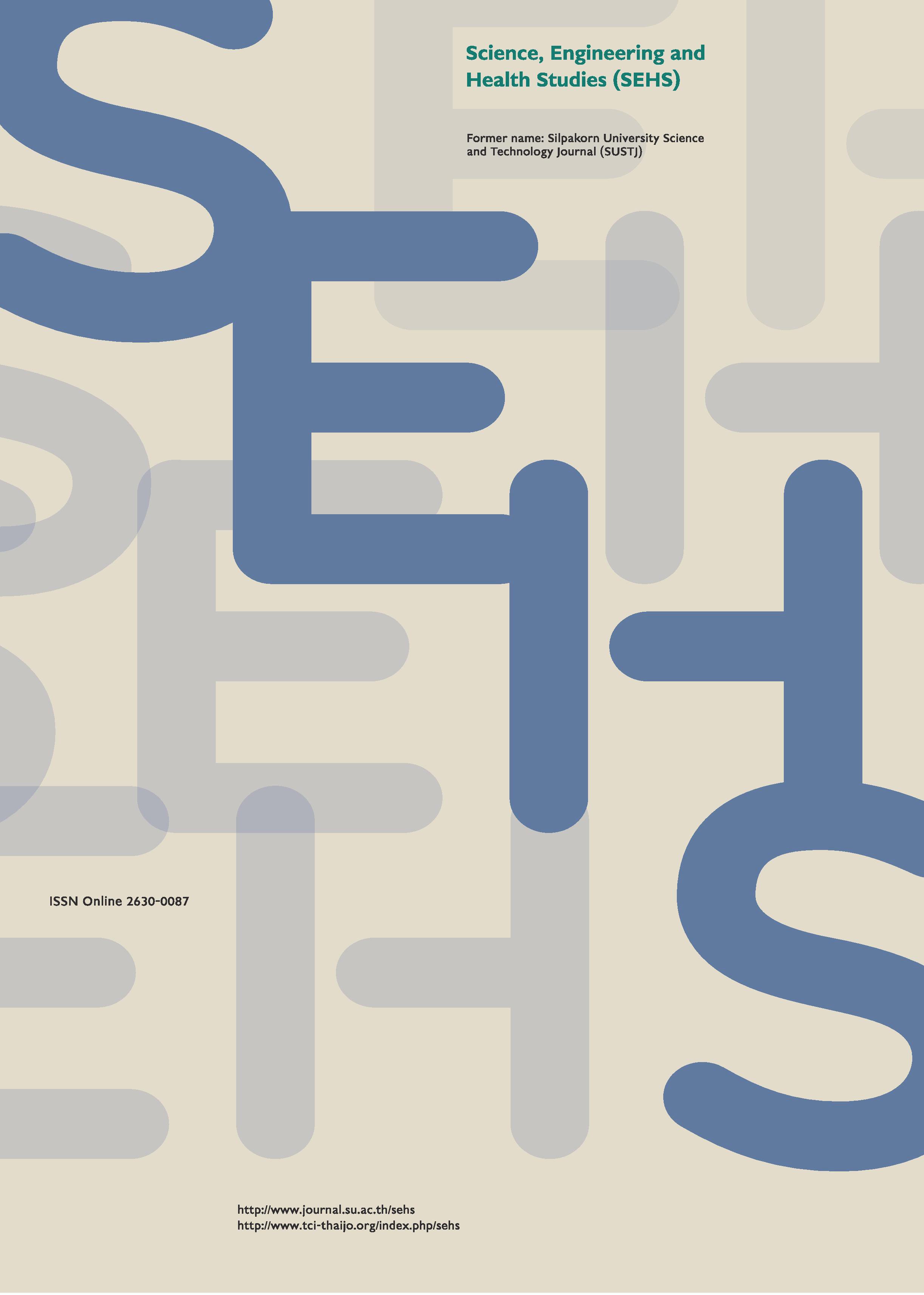Selenium nanoparticles biosynthesized by garlic extract as antimicrobial agent
Main Article Content
Abstract
Staphylococcus aureus is an important human pathogen. Its drug resistance strains could result in hospital-acquired infections. In recent years, the use of nanoparticles has become a new approach to combat antibiotic-resistant bacterial strains. In the present study, green synthesis of selenium nanoparticles (SeNPs) was conducted using garlic (Allium sativum) extract (G). Formation of SeNP-G was characterized by red brick solution with maximum absorbance in the range of 270-280 nm. Particles formed at 4 h (SeNP-G4) and 72 h (SeNP-G72) of incubation were spherical in shape with size range within 21-40 nm and 41-50 nm, respectively. Zeta potential analysis of the particles was at -23.8 mV and -24.2 mV, respectively. These SeNP-G exhibited higher antibacterial activity than garlic extract in a dose-dependent manner by agar diffusion method and broth dilution assay. However, no significant difference in antibacterial capability was observed between these two particle sizes. SeNP-G72 was less cytotoxic to normal human MRC-5 cell than SeNP-G4 and sodium selenite. Thus, green nanotechnology could be used to reduce toxicity of sodium selenite and enhance antibacterial activity of garlic extract by using SeNP-G as a potential antibacterial agent against S. aureus.
Downloads
Article Details
References
Anu, K., Singaravelu, G., Murugan, K., and Benelli, G. (2017). Green-synthesis of selenium nanoparticles using garlic cloves (Allium sativum): Biophysical characterization and cytotoxicity on vero cells. Journal of Cluster Science, 28 (1), 551-563.
Durairaj, C., Kim, S. J., Edelhauser, H. F., Shah, J. C., and Kompella, U. B. (2009). Influence of dosage form on the intravitreal pharmacokinetics of diclofenac. Investigative Ophthalmology & Visual Science, 50(10), 4887- 4897.
Ezhuthupurakkal, P. B., Polaki, L. R., Suyavaran, A., Subastri, A, Sujatha, V., and Thirunavukkarasu, C. (2017). Selenium nanoparticles synthesized in aqueous extract of Allium sativum perturbs the structural integrity of calf thymus DNA through intercalation and groove binding. Materials Science and Engineering, 74(1), 597-608.
Fardsadegh, B., Vaghari, H., Mohammad-Jafari, R., Najian, Y., and Jafarizadeh-Malmiri, H. (2019). Biosynthesis, characterization and antimicrobial activities assessment of fabricated selenium nanoparticles using Pelargonium zonale leaf extract. Green Processing and Synthesis, 8(1), 191-198.
Fujisawa, H., Suma, K., Origuchi, K., Kumagai, H., Seki, T., and Ariga, T. (2008). Biological and chemical stability of garlic-derived allicin. Journal of Agricultural and Food Chemistry, 56(11), 4229-4235.
Guisbiers, G., Wang, Q., Khachatryan, E., Mimun, L. C., Mendoza-Cruz, R., Larese-Casanova, P., Webster, T. J., and Nash, K. L. (2016). Inhibition of E. coli and S. aureus with selenium nanoparticles synthesized by pulsed laser ablation in deionized water. International Journal of Nanomedicine, 11, 3731-3736.
Hosnedlova, B., Kepinska, M., Skalickova, S., Fernandez, C., Ruttkay-Nedecky, B., Peng, Q., Baron, M., Melcova, M., Opatrilova, R., Zidkova, J., Bjorklund, G., Sochor, J., and Kizek, R. (2018). Nano-selenium and its nanomedicine applications: a critical review. International Journal of Nanomedicine, 13, 2107-2128.
Khiralla, G. M., and El-Deeb, B. A. (2015). Antimicrobial and antibiofilm effects of selenium nanoparticles on some foodborne pathogens. LWT - Food Science and Technology, 63(2), 1001-1007.
Lin, Z. H., and Chris Wang, C. R. (2005). Evidence on the size-dependent absorption spectral evolution of selenium nanoparticles. Materials Chemistry and Physics, 92(2-3), 591-594.
Menon, S., Shrudhi Devi, K. S., Santhiya, R., Rajeshkumar, S., and Venkat Kumar, S. (2018). Selenium nanoparticles: A potent chemotherapeutic agent and an elucidation of its mechanism. Colloids and Surfaces B: Biointerfaces, 170, 280-292.
Mittal, A. K., Chisti, Y., and Banerjee, U. C. (2013). Synthesis of metallic nanoparticles using plant extracts. Biotechnology Advances, 31(2), 346-356.
Nguyen, T. H. D., Vardhanabhuti, B., Lin, M., and Mustapha, A. (2017). Antibacterial properties of selenium nanoparticles and their toxicity to Caco-2 cells. Food Control, 77, 17-24.
Qing, Y., Cheng, L., Li, R., Liu, G., Zhang, Y., Tang, X., Wang, J., Liu, H., and Qin, Y. (2018). Potential antibacterial mechanism of silver nanoparticles and the optimization of orthopedic implants by advanced modification technologies. International Journal of Nanomedicine, 13, 3311-3327.
Ramamurthy, C., Sampath, K. S., Arunkumar, P., Suresh Kumar, M., Sujatha, V., Premkumar, K., and Thirunavukkarasu, C. (2013). Green synthesis and characterization of selenium nanoparticles and its augmented cytotoxicity with doxorubicin on cancer cells. Bioprocess and Biosystems Engineering, 36(8), 1131-1139.
Ratthawongjirakul, P., and Thongkerd, V. (2016). Fresh garlic extract inhibits Staphylococcus aureus biofilm formation under chemopreventive and chemotherapeutic conditions. Songklanakarin Journal of Science and Technology, 38(4), 381-389.
Sharma, G., Sharma, A. R., Bhavesh, R., Park, J., Ganbold, B., Nam, J. S., and Lee, S. S. (2014). Biomolecule-mediated synthesis of selenium nanoparticles using dried Vitis vinifera (raisin) extract. Molecules, 19(3), 2761-2770.
Skov, R. L., and Jensen, K. S. (2009). Community-associated meticillin-resistant Staphylococcus aureus as a cause of hospital-acquired infections. Journal of Hospital Infection, 73(4), 364-370.
Tran, P. A., and Webster, T. J. (2011). Selenium nanoparticles inhibit Staphylococcus aureus growth. International Journal of Nanomedicine, 6, 1553-1558.
Vyas, J., and Rana, S. (2017). Antioxidant activity and green synthesis of selenium nanoparticles using allium sativum extract. International Journal of Phytomedicine, 9(4), 634-641.
Wang, J. C. , Neogi, P., and Forciniti, D. (2006). On one-dimensional self-assembly of surfactant-coated nanoparticles. The Journal of Chemical Physics, 125(19), 194717.
Zhang, J., Gao, X. Y., Zhang, L. D., and Bao, Y. P. (2001). Biological effects of a nano red elemental selenium. Biofactors, 15(1), 27-38.


